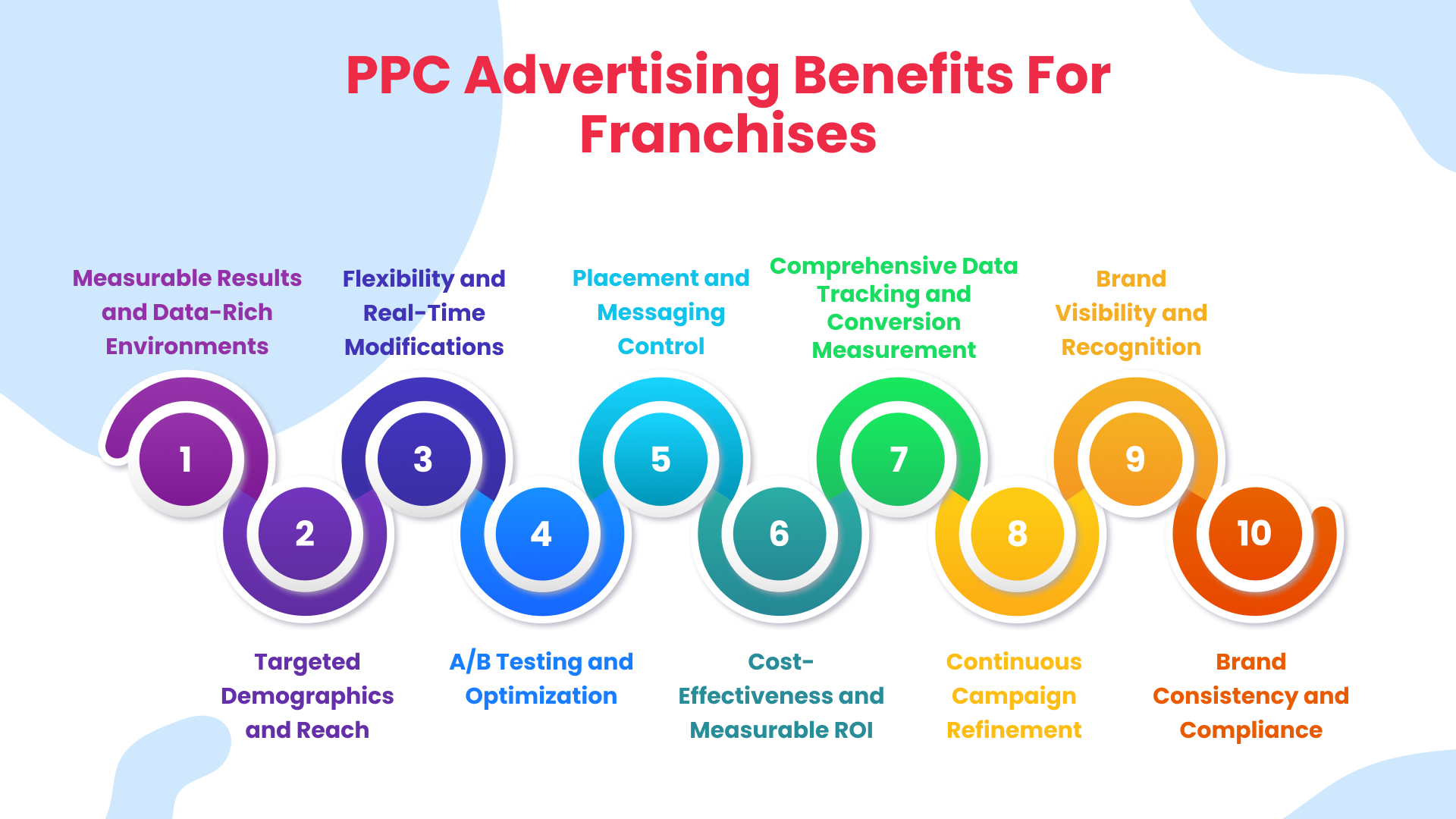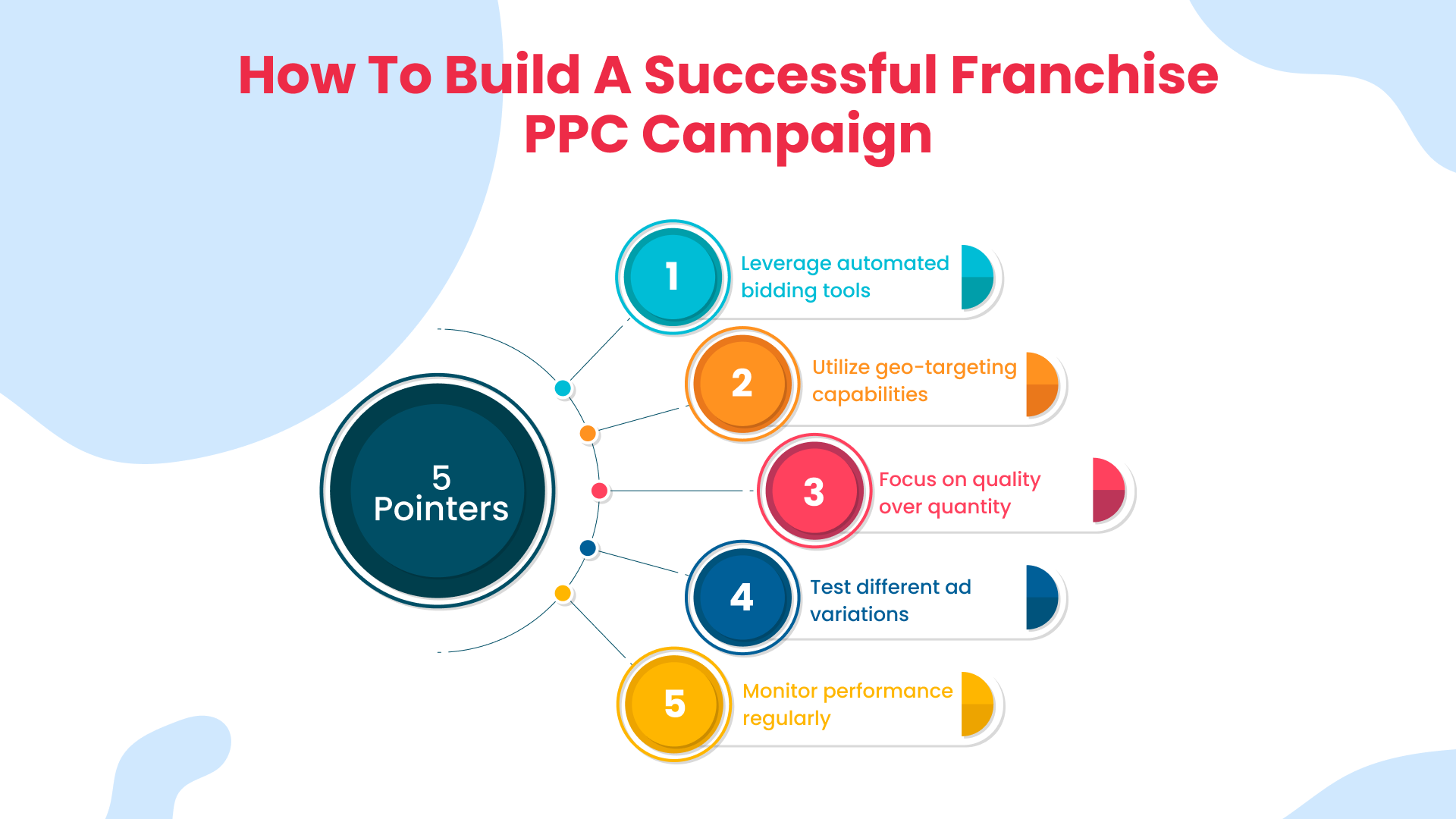PPC for Franchise Businesses: Tailoring Campaigns for Multiple Locations
Effective franchise marketing strategies play a pivotal role in determining the success of the entire business model. How individual franchisees market their locations can significantly influence their success and impact fellow franchisees and the business’s overall health.
Key Franchise Marketing Strategies: SEO, PPC, and Social Media Marketing
Developing a strong brand identity for a franchise involves key digital marketing strategies, notably SEO, PPC, and social media marketing. A successful franchise marketing campaign integrates paid advertising and organic content efforts to enhance brand and location visibility.
Search Engine Optimization (SEO) for Franchises:
SEO is vital for creating brand awareness and attracting potential customers to franchise locations. SEO is the foundation for connecting with motivated consumers and guiding them through their buying journey by making your franchise easily discoverable in search engines. Over 75% of mobile users visit local establishments within a day after searching for goods or services, underscoring the importance of a robust online presence. SEO involves optimizing your franchise website and locations to appear in relevant searches, ensuring potential customers can easily find you.
What Is Franchise PPC Advertising?
Franchise PPC Advertising is a dynamic marketing strategy that empowers franchises to promote their businesses through PPC models. This approach involves displaying ads prominently on search engine result pages (SERPS) and various online platforms, precisely targeting the desired audience. The benefits of franchise PPC advertising include a targeted approach, measurable results, and cost-effectiveness, enabling increased brand visibility, qualified traffic, and valuable lead generation. Leveraging PPC campaigns allows franchises to establish a robust online presence, compete with industry leaders, and expand their reach across multiple locations.
The Importance of PPC for Franchise Marketing:
User intent for online searches falls into four categories: Informational, Navigational, Commercial, and Transactional. Securing top placement on SERPs ensures that your brand remains top of mind for users with high-intent searches, positioning you alongside established competitors. Unlike the time-intensive nature of SEO efforts, PPC advertising provides the advantage of immediately driving targeted traffic. This is particularly crucial for new franchisees looking to build brand awareness in a new city or region swiftly.
PPC Advertising Benefits for Franchises:

Measurable Results and Data-Rich Environments:
PPC provides precise measurement metrics, offering detailed insights into campaign performance. This data-driven approach empowers franchisees to analyze key performance indicators like clicks, impressions, conversions, and cost per acquisition.
Targeted Demographics and Reach:
Franchises leverage PPC to target demographics based on location, age, interests, and search behavior. This targeted approach ensures ads reach the most relevant audience, increasing the likelihood of conversions, which is especially valuable for local marketing efforts.
Flexibility and Real-Time Modifications:
PPC offers unparalleled flexibility, allowing real-time adjustments to campaigns. Franchises can instantly refine ad copy, targeting parameters, and bidding strategies based on performance data and market dynamics.
A/B Testing and Optimization:
A/B testing in PPC enables experimentation with different ad variations to identify the most effective elements. Testing headlines, images, calls to action, or landing pages allows franchises to optimize for maximum click-through rates and conversions.
Placement and Messaging Control:
Franchisors maintain control over ad placement and messaging in PPC. They select specific platforms or search engine result pages, ensuring alignment with the target audience.
Cost-Effectiveness and Measurable ROI:
PPC’s pay-per-click model ensures cost-effectiveness as advertisers only pay for actual engagement. Franchises set budgets, monitor costs, and maximize ROI by eliminating the risk of paying for non-engaging ad placements.
Comprehensive Data Tracking and Conversion Measurement:
PPC platforms provide comprehensive data tracking capabilities. Franchises can monitor metrics like impressions, clicks, click-through rates, conversions, and cost per click. Conversion tracking allows the measurement of specific user actions post-click.
Continuous Campaign Refinement:
Measurable results and analytics enable ongoing refinement of PPC campaigns. Franchises continuously optimize based on data analysis, making iterative adjustments for improved performance.
Brand Visibility and Recognition:
Consistent PPC presence enhances brand visibility and recognition by prominently featuring franchises in search engine results. This fosters brand authority, and trust, and attracts new leads.
Brand Consistency and Compliance:
PPC marketing allows franchisors to maintain brand consistency by controlling ad messaging. Centralized reporting and monitoring features in PPC platforms ensure adherence to brand guidelines across multiple franchise locations.
Relatable Read:
Boost Your PPC Campaigns with AI: A Comprehensive Guide
The Value of PPC: Pros and Cons for SMBs Unveiled
Revamp Your 2024 Strategy with 8 Game-Changing PPC Trends
Step By Step Guide to Create a Franchise PPC Campaign
PPC strategies work best when they’re highly targeted. The point of paid advertising should never be to pepper the digital landscape with information about your franchise and hope for the best. Instead, you should tailor ad campaigns to target audiences via strategies designed to inform the right people about your products at the right time.
Pre- Requisites
Keyword research
Keyword research helps you identify the terms your target audience is looking for, how difficult the competition is, and how much you should expect to pay for your targeted keywords and phrases. This will help you refine the keywords for the PPC campaigns and can also assist in formulating other marketing strategies.
Long Tail Keywords
When bidding for keywords, you can put a limit on the amount you are willing to spend each time your ad gets clicked. Some keywords cost far more than others due to their competitiveness. A broad keyword, such as “PPC,” will have thousands of advertisers competing for it. However, if you use a long-tail keyword like “PPC for Franchise Marketing, NY,” your cost per click will be far lower since the competition may be lower. It will also enable you to target the right ICP for your offerings.
Research and analyze competitors: Knowing your franchise’s competitive landscape is essential for crafting a successful franchise PPC strategy. Research the keywords, ad copy, bidding strategies, and other tactics used by competing franchises to inform your own franchise PPC campaigns.
Step 1: Set up campaign goals
Before launching any franchise PPC campaigns, developing a clear strategy that outlines goals and objectives is essential.
Define who you want to target, what action you want them to take (e.g., visit a website or make a purchase), how much you are willing to spend to get those desired results, and other key metrics such as cost per acquisition (CPA) and return on ad spend (ROAS).
You can consider a SMART Framework to frame the Goals for the campaign:
For example, a smart goal for a B2C swimming pool repair franchise looking to grow might be:
“generate 2x qualified web leads by Q2. It’s direct and clear (S), measurable through form submission (M), attainable (A), has a deadline, and is relevant to the franchise’s overall goal of growth.
Step 2: Consider your ideal buyer
Before starting a campaign, developing buyer personas or Ideal Customer Profiles (ICPs) to guide your campaign is essential. They describe the traits of an ideal buyer or franchisee you like working with best. They contain information like relevant demographics, motivations, challenges, and common sales objections.
Franchises do business with different types of people and have more than one of these. So, jot down the different personas (try to make at least 3). This step is important as even if you have a clear idea of what these groups of people look like, not everyone on your team may have a crystal-clear idea of who they’re addressing daily.
Step 3: Determine your franchise PPC campaign’s Scope
It is ideal to start with a short, lower-budget PPC campaign to test the waters and gather baseline ad performance data before laying down serious money.
Consider the campaign duration. How would this integrate with a broader marketing strategy such as SEO?
Step 4: Ensure Your Site is Lead-Ready
Before starting a PPC campaign it is critical that have the marketing and sales infrastructure in place to effectively convert and manage the leads you generate.
This means you need a CRM to manage the lead process and keep your sales team on the same page.
When users click on your PPC ads, directing them to carefully optimized landing pages is crucial for campaign success. The content on these pages must align with your ad promises and be structured for effective conversions.
Match Ad Description: Ensure your landing page content precisely matches what is described in your ad. Consistency is key to avoiding user dissatisfaction and high bounce rates.
Incorporate a Call-to-Action (CTA): Include a CTA on your landing page, encouraging visitors to take a specific action based on your business goals (e.g., make a purchase, sign up, or fill out a contact form).
Optimize Page Load Time: Minimize landing page load times to under 3 seconds to prevent potential customers from bouncing to faster-loading sites.
A/B Testing for Optimization: Conduct A/B testing on your landing pages to identify elements contributing to higher conversion rates. Test variations and analyze data to refine your page for optimal performance.
If using multiple ad groups targeting different aspects of your franchise, create landing pages specifically tailored to each group. Implement “conversion coupling” by ensuring your landing page’s message aligns seamlessly with your PPC ad. Communicate the offer, guide visitors to sign up, provide program insights, maintain simplicity, and highlight the desired next steps.
Step 5: Choose search terms
Research with a tool like Google Keyword Planner and choose which terms to bid based on your campaign goals and offers. You can bid on keywords manually or choose from one of Google Ads’ smart bidding (automated) options. The latter is probably a better option, particularly if you’re new to PPC.
Step 6: Set up your campaign
Next, you want to configure your campaign settings to reach your target audience. You can fine-tune based on time of day, location, languages, and more.
Step 7: Set up your ad groups
Select keywords and organize them into ad groups according to location and search intent. For example, if you operated a cleaning business, you could create a separate ad group for each service offering, such as house cleaning and move-out cleaning.
For each ad set, create at least three distinct ads to maximize the possibility of a particular ad piquing your viewer’s fancy and to better compare performance.
Finally, add a lead form right in Google ads that clickers can fill out and create a custom landing page for each ad set that uses the same keywords and messaging your ads do.
Step 8: Tweak
After sufficient time, review your campaign, adjust, optimize, and get the best ROI from your ad spend.
Review and remove keywords that aren’t getting conversions, are showing up for irrelevant results, or are otherwise not giving you a good return.
Do a Cost/benefit analysis with your ads. Which ads have the highest click-through and conversion rates? If an ad has a below-average conversion rate and click-through rate, pause it and consider replacing it with a new ad that’s more like the ads that are working.
You can customize how much money you’ll pay per click within specific parameters like time of day or location. For example, if you’re located between cities and you get more valuable leads from one than the other, you can increase your budget for ad clickers located in the preferred city, while the budget remains the same for the other.
You can evaluate and explore different scenarios to gain a clear idea of the PPC metric with the ROAS calculator.
Also Read: Hyper-Local PPC: Targeting Audiences on a Street-Level
How to build a Successful Franchise PPC campaign

(1) Leverage automated bidding tools: Automating franchise PPC can save time and money while improving campaign performance. By using automated bid management tools such as Google Ads Smart Bidding or Facebook’s Bid Capabilities, franchisors can quickly adjust bids in response to market conditions or user behavior changes.
(2) Utilize geo-targeting capabilities: Geo-targeting allows franchisors to target customers based on their physical location. This can be especially useful for franchise businesses with multiple locations, as franchisors can tailor campaigns to target customers in specific markets or regions.
You should select the location settings based on the area each franchise serves. The more franchises in each area, the smaller each campaign’s geo-targeting radius will be.
But if your service is something people need fast – think urgent care or something similar – people will look for locations as close to them as possible.
(3) Focus on quality over quantity: It’s important to focus on the quality of franchise PPC ads rather than the sheer volume of ads. Make sure your ad copy is engaging and relevant to its intended audience, and use any available targeting options such as demographic, geographic, and device targeting.
(4) Test different ad variations: Testing multiple versions of franchise PPC ads allows marketers to determine which ones are performing best and optimize accordingly. Be sure to A/B test creatives (e.g., images, videos), copy elements (e.g., headlines, descriptions), and other variables to determine which franchise PPC ads generate the most conversions.
(5) Monitor performance regularly: Franchise PPC campaigns are constantly changing, so it’s important to keep track of key metrics such as impressions, clicks, and cost-per-click (CPC). Regularly monitoring franchise PPC performance allows you to identify areas for improvement or optimization opportunities to maximize ROI.
With the right franchise PPC strategies, franchise businesses can increase their reach and visibility by targeting customers in specific regions or markets, improving brand awareness among potential customers, and optimizing campaign performance to maximize returns on their advertising investments.
Related Articles
SEO Boosters: 8 User Experience Signals for Higher Rankings!
SEO Tracking: Key Metrics for Business Owners to Track
Let Us help you!
Have a question for our team? Want to learn more about what we offer? Already know what your company needs and just want to have a conversation with us?
Follow us for more helpful content.
Let Us help you!
Have a question for our team? Want to learn more about what we offer? Already know what your company needs and just want to have a conversation with us?
